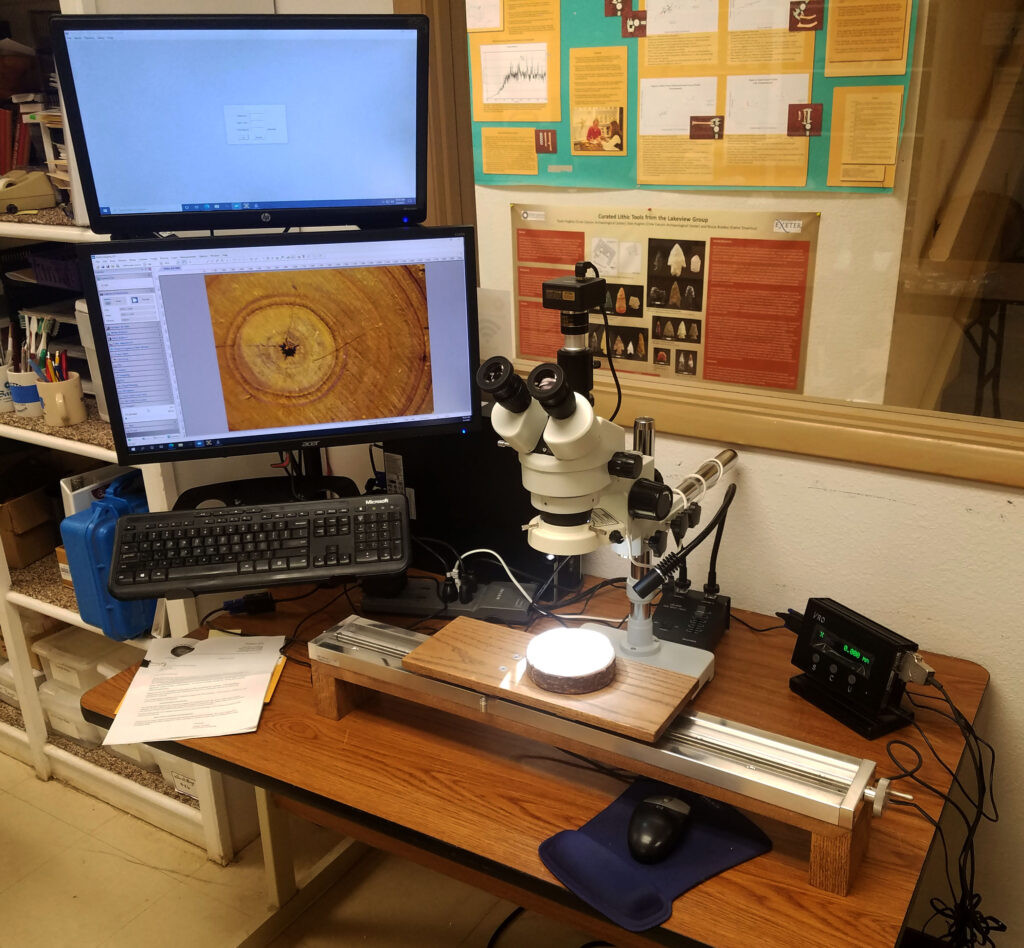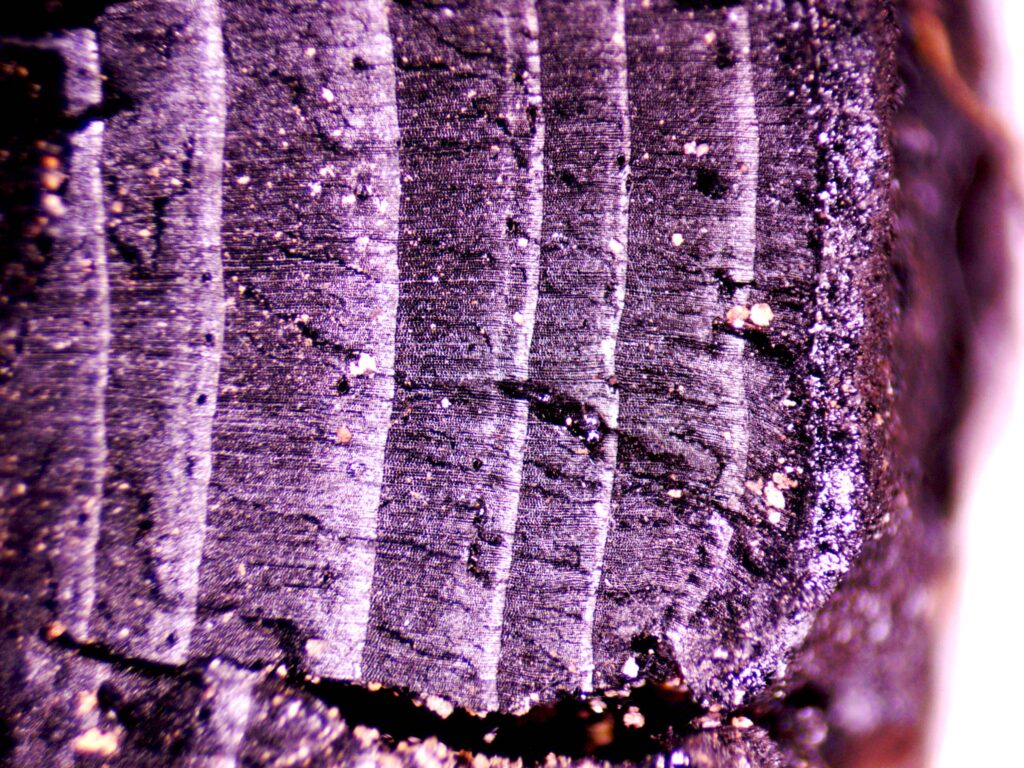In an effort to predict the future, scientists are piecing together an astonishingly precise and far-reaching record of the past.

In these uncertain times of drought and ever-falling reservoirs and aquifers, the ability to anticipate climate change has taken on new importance. Knowing where we’re heading requires knowing where we have been, yet our grasp of climatic history is incomplete and imprecise. However, significant gaps are being filled in through the ever-evolving study of tree rings. Dendrochronology is a nearly century-old science extending and fine-tuning our knowledge of the planet’s history. Ben Bellorado, Laboratory Director at the Crow Canyon Archaeological Center in southwestern Colorado, is part of that effort. He recently talked with Clay about his work and what tree rings say about our burgeoning water crisis.
This article is part of a series on Water in the West. The interview has been edited for length and clarity.
Clay: Let’s start with the basics. What is dendrochronology, and how is it useful?
Ben Bellorado: Dendrochronology is the study of tree time. It breaks up in Latin to dendro meaning tree, chronos meaning time, and then -ology meaning “the study of.” There are subfields, including dendroarchaeology, dendrohydrology, and dendroecology, but dendrochronology is the broader term. Its development was spearheaded back in the 1920s by a man named Andrew Douglass. He started as an astronomer, but while he was working at the Lowell Observatory in Flagstaff, he and a colleague saw the potential of using tree rings to date archeological sites. He had access to the tools of an astronomer, so he actually started off looking at tree rings from across the room with a telescope. Working with other scientists, he figured out that not only did most tree species add a ring every year, but that by looking at the relative thickness of those rings, you could tell things like how much precipitation fell in that year or if a warmer or colder climate had affected the growth of that tree. Once you’ve examined a tree, you try to locate other trees from the same area but from different eras, and this allows you to work your way further and further back in time. Here in the Four Corners area of the United States, our oldest chronology goes back to about 212 B.C., but in the White Mountains of California, it goes back about 10,000 years. Central Europe also has chronologies going back five to ten thousand years.
Dendrochronology is the study of tree time. It breaks up in Latin to dendro meaning tree, chronos meaning time, and then -ology meaning “the study of.”
Ben Bellorado
Clay: Is it accurate then to think of dendrochronology as the history of the planet as viewed through a tree-ring lens?
Ben Bellorado: Exactly. It’s the most accurate and finely controlled way we have to track changing conditions through time across the world. Potentially you have not only annual resolution but sub-annual and even seasonal resolution. When we’re really lucky, we can tell you not just the year that a tree was cut down, but whether it was cut down in the fall or the spring or mid-summer. And we can learn about certain events that occurred during its lifetime. You can date the occurrence of events such as avalanches and rockslides or the eruption of volcanoes.
Clay: What happens in the tree ring record when these events occur? How does the eruption of a volcano create possibilities for future dendrochronologists?

Ben Bellorado: We can actually look at the different isotopes that are present in different parts of the tree’s life. Local trees that aren’t immediately wiped out by the magma are going to take in a lot of the chemicals and gases and such that are released with the volcano. And then there are ripple effects. The volcano can put so much ash into the air that you have dramatic cooling events, what we might call “little ice ages.” Throughout a lot of North America in the 1400s, for example, there was a really cold period that lasted about fifty years. By looking at these large data sets that we’ve put together, we’ve been able to tie that period of extreme cold to the eruption of volcanoes. We’ve built massive data sets and we’re able to share them across the world. We can look at how certain parts of the world were affected by extreme weather events in the past, and then hopefully improve our ability to predict what will happen in the future. Predicting things is difficult, but understanding what’s happened in the past is still a good place to start.
Clay: How complete and dependable are these records that you can extract from tree rings?
Ben Bellorado: As an archaeologist, I have to be careful. Obviously, it’s only the things that get preserved in the archeological or natural record that we can recover and know about. A lot of trees and plants decay and go away. Our window into ancient times is limited to things that were preserved. We call that preservation bias, and we have to remain aware of it. And then there is recovery bias. Our understanding of the archeological distribution is dependent on what sites we select for study. And sometimes a road might go in somewhere and things get destroyed before we have the chance to look.

Clay: How do you approach a new sample? Suppose for example that you observe rings with expected widths in the early years of a tree’s life, but notice that they suddenly grow abnormally thin. What questions do you begin to ask?
Ben Bellorado: The thickness of the ring is reflective of the precipitation and the temperature. If the tree grows at low elevation, the first thing I’m going to think of is that there was a downturn in the precipitation. If it is one ring, I will think it was a dry year. If it’s multiple years in a row, then I’m going to say there was a pretty significant downturn in the climate. But you have to also think about where you are in the cross section. Trees always have bigger rings in the early years of their life. There’s an expected age-related growth trend. But if you see a big separation from that trend, then you know that something else is going on. Another thing to consider is where this tree was growing. If you have a dense forest, all those trees are competing with each other for nutrients, precipitation, and for light. So if there’s a big event like a landslide that cleans out a bunch of trees all at once, the surviving trees that are growing on the edge of that destruction are going to suddenly have a lot more nutrients and sun. In that case the rings are going to get bigger. You have to think about things like that.

Clay: How has this work informed your thoughts about the drought that we’re in the midst of?
Ben Bellorado: We can accurately and precisely track the changes. We can see exactly what’s happening. We have to stop polluting the environment, and we have to stop using so much water. Even if we manage to do those things, there will still be major issues. If we can’t turn it around, or if the climate doesn’t turn around on its own, big parts of North America are not going to be habitable. There’s only so much water, and there’s not a way to make new water. We are going to be forced to seriously think about where and how we are living. It wouldn’t surprise me if in the next hundred years, there are not as many people living in places like Phoenix and parts of California. That’s my personal point of view. I don’t think we’ve made the effort required to prevent people from having to move. That’s something that has happened throughout human history, but the scale of it now would be astronomical because we have such high populations that are so sedentary and entrenched. It’s going to be hard. There’s going to be political and social strife, and the systems we have now might not survive that. I’m just thinking realistically after looking at those ancient cultures. Like us, they thought they were permanent, but they peaked, waned, and went away, and others replaced them. From a climate point of view, I just don’t see an easy way out for any of us. Still, I do think there’s a lot of really intriguing science that could help us. One thing that fascinates me right now is the idea of putting floating electric generators in the ocean so that the tides and the movement of the water generate electricity. We should be putting so much more time and energy and money into that type of research.
Clay: The snowpack was up this winter, as much as 200% in some places. What do the trees tell us about the significance of this? Could we be at the beginning of forty wet years?
Ben Bellorado: Potentially we could be, but there are spikes in the driest of droughts, and when you look at the average, it doesn’t change much. This year’s snowpack is helpful, but it doesn’t solve the situation. It’s a blip, a drop in the bucket. We need 20 years or more of these winters to refill all the reservoirs and all the aquifers. It’s the long-term depletion of these water systems that is the problem.

Clay: As an archaeologist, it seems that you hang out all day in the middens of civilizations that have collapsed, but on the other hand you know from the work you do that this too will pass, and other things will come along. Are you an optimist or a pessimist, or do you oscillate between the two?
Ben Bellorado: Just ask my therapist. Seriously, we do see the waxing and the waning of these different cultures. I’m hopeful that human civilization won’t go away. Humans are resilient. Culture is the most beautiful and amazing thing. We all do the stupidest things at times, but it’s a beautiful system that we’ve put together. It’s constantly changing and adapting. Look at indigenous people around the world. They can adapt in what seem to us to be the most inhospitable places in the world. In northern Canada you have folks living in igloos with fur suits and oil lamps, and they’re happy. They have a thriving culture. It gives me a sense of wonder, but it also makes me aware of things we are doing that are less than advantageous. Sometimes we do things that initially help us out, but down the road there are unintended consequences.
